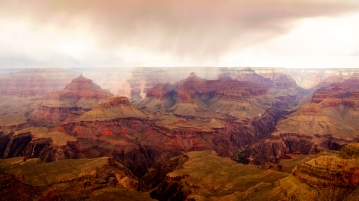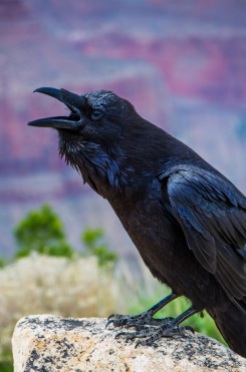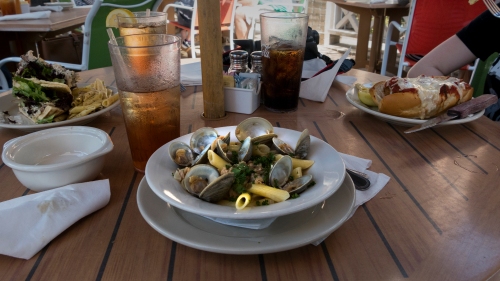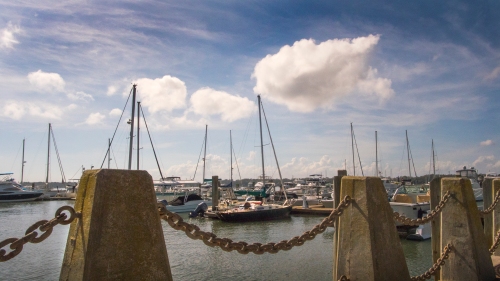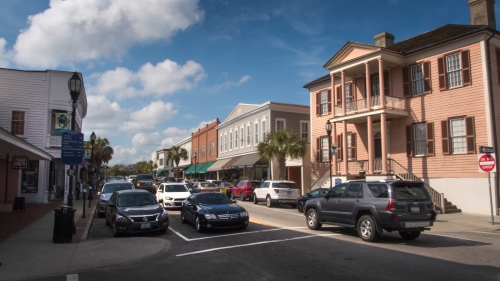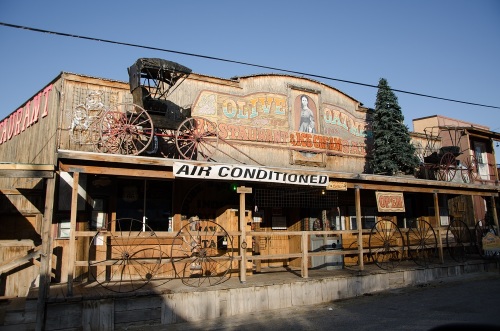Visit our main website at SoutheasternBound.net. We post history/travel every Monday, then photos/photo tips each Thursday. Please click the Follow button (below right) for updates on Southeastern Bound.
By JD Byous
My father never stopped at the Grand Canyon. My father would — not — stop. Never. Ever. Never-ever… unless of course, he had to use the bathroom and then it was a Whiting Brothers gas station to fill up and find relief. Cruising down Route 66 twice each year I would drool, yearn and whine that we might turn on Route 64 from Williams, Arizona to see the hole in the ground that I’d been told about in school, read about, and wished to visit. Didn’t happen. Not once. The 120-mile round trip would add almost ten percent to our drive to Eastern Oklahoma and the visit with family. His last trip through was to move there, the destination of all of our trips. He died a few years later.

As the sun rolls past the colors change, just like they are advertised to do. Fabulous.
Well…, not really never-ever. I do remember one side trip. We did stop at Meteor Crater after I had hounded for several hours. I wore them down, I guess. That’s another story, however… That was when my mom made a statement that would place a bookmark on my eighth year of life… “It’s nothing but a big hole in the ground.” She actually used an expletive somewhere in the sentence. However, you think about it, she’s right. But, oh, what a hole in the ground. I was hooked on large, naturally excavated terrain with that viewing.
But I digress.

Meteor Crater, just a big… hole that I find fascinating. More to come in another blog.
Fast forward fifty-plus years… Okay, make that almost sixty-plus years. But, I am finally here. As always, time is short, and to make it worse the Beckster and I have some kind of bug. I do not feel like touring, I’d prefer to lay in the motel and whine. But, the road calls. Time dictates and demands, “See it now ‘cause you may not be back for a while… or ever.” So we go.

An odd, pockmarked rock on the south rim.
We leave Sedona in the morning heading out on route 89a and up its famous switchbacks that I dubbed, The Hairpins. The road reminds me of a shoestring. It twists and turns and loops, so crooked that, as my father used to say, “You can see your tail lights as you round the bend.” This road is definitely bendy and loopy, not for the faint of stomach. The Hairpins climb from the junction of Pumphouse Creek and Sterling Canyon then past 6,639-foot, Mexican Pocket Mountain then dumps you onto the long plateau that leads to Interstate 17 and Flagstaff. At Flagstaff, we follow US 180 to Arizona 64 and we are here – two and one-half hours later.

Mather Point Overlook. Nice folks, but one must look beyond the spilled drinks and crowds because the beauty is there. It’s worth it. One look and you forget your immediate surroundings.
We are here. Yes, we are. Along with what appears to be half the population of the Western Hemisphere. At Mather Point, we park at the Visitors Center lot. A short walk and we on the overlook. People are scrambling everywhere… I mean, everywhere. Hanging off of the rails to pose for pictures, on outcrops of rocks to our left… posing for pictures, off of the overlook a few hundred yards to the west… posing for pictures.
Selfie sticks flash in the sunlight looking like a rerun of the battle scene on Braveheart. And, children running everywhere, climbing on rocks, climbing on rails. My inner-parental-self stands, stunned and silent. Coffee or some other brown runny substance rolls from a coffee cup on the concrete path ahead. The aroma of coffee wafts up, affirming the contents. I hope that the Beckster doesn’t get a whiff. We’ll be searching for a McDonalds, because, as you know, they make the best coffee. It’s a Beckster thing.

Looking north from Mather Point Overlook. A man in a red shirt hangs near the edge for a prank photo. It HAD to be a guy in red.
Then it hits me. Blamm! The view. It’s 10 a.m. and past the “sweet” light of the morning and it’s beautiful. No, bad example, exquisite. No, not enough, still. Wow! That works, just, wow! Clouds cover the Northern Rim. Rain falls from the patches of blue and white fluff. The red-orange banding along the mass of mesas, cliffs, and side canyons are like a light show in rock. Grab a camera. I alternate between DSLR and smartphone. It’s hard to get a bad shot. I am impressed. I am really impressed. I wish my parents were here. They should see this. They would have liked this big hole.
We no longer feel ill. Somehow the bad has been erased so we point our pickup east along the rim drive. As the sun climbs and the clouds move the scene changes. I had read how the colors change with the day. Oh, my God, what have you done here? This is beyond words. Each turnout and overlook has its own phenomenal view. At one stop, a raven poses for me, then squawks a rebuke when I’ve overstayed my welcome. We move on. If I were shooting film we would have burned through several hundred dollars in emulsion and processing fees. Man, I love digital.

Navajo Jewelry shop Navajo Reservation
Before we know, we arrive at the Desert View Visitor Center, the end of the line. The views and the images are still great. Just one more picture and we need to head back. We’ve burned through the entire day. Down the road we make one more stop, a Navajo jewelry stand. Here a Viet Nam veteran and his wife offer beaded jewelry, dream catchers and pottery. As the sun drops low it is cold so we keep moving, but after buying gifts for the kids and grandkids and earrings for the Beckster. Oh, and something for me, a stone circle pendant. I like it. It’s made by nice people, or at least sold by them. I wish we had time to stay and talk but the road calls.

Mary Colter’s Desert View Watchtower marks the end of the view sites on the South Rim Drive.
It is a great day. I am ready for a nap but we still have to drive the Hairpins after dark. The Grand Canyon? I will be back.
Too bad Dad couldn’t be here.
© J Byous Company 2018, All rights reserved


